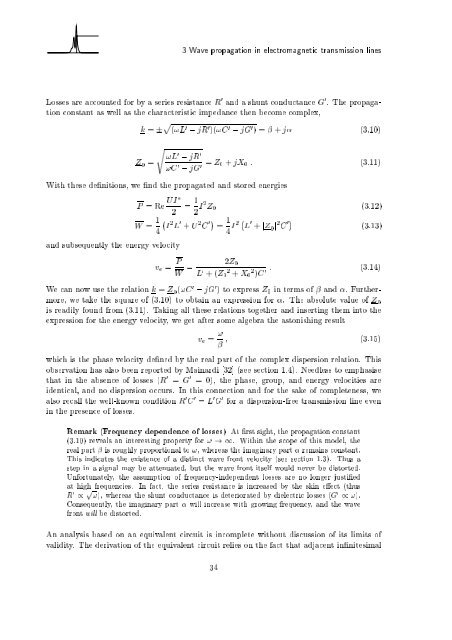Wave Propagation in Linear Media | re-examined
Wave Propagation in Linear Media | re-examined
Wave Propagation in Linear Media | re-examined
You also want an ePaper? Increase the reach of your titles
YUMPU automatically turns print PDFs into web optimized ePapers that Google loves.
3<strong>Wave</strong> propagation <strong>in</strong> electromagnetic transmission l<strong>in</strong>es<br />
Losses a<strong>re</strong> accounted for by a series <strong>re</strong>sistance R 0 andashunt conductance G 0 . The propagation<br />
constant aswell as the characteristic impedance then become complex,<br />
k = p (!L 0 , jR 0 )(!C 0 , jG 0 )= +j (3.10)<br />
Z 0 =<br />
s !L 0 , jR 0<br />
!C 0 , jG 0 = Z0 + jX0 : (3.11)<br />
With these de nitions, we nd the propagated and sto<strong>re</strong>d energies<br />
P =Re UI<br />
2<br />
W = 1<br />
4<br />
and subsequently the energy velocity<br />
= 1<br />
2 I2 Z0<br />
, I 2 L 0 + U 2 C 0 = 1<br />
4 I2 , L 0 + jZ 0j 2 C 0<br />
ve = P<br />
W =<br />
(3.12)<br />
(3.13)<br />
2Z0<br />
L0 +(Z0 2 +X0 2 : (3.14)<br />
)C0 We can now use the <strong>re</strong>lation k = Z 0(!C 0 , jG 0 ) to exp<strong>re</strong>ss Z0 <strong>in</strong> terms of and . Furthermo<strong>re</strong>,<br />
we take the squa<strong>re</strong> of (3.10) to obta<strong>in</strong> an exp<strong>re</strong>ssion for . The absolute value of Z 0<br />
is <strong>re</strong>adily found from (3.11). Tak<strong>in</strong>g all these <strong>re</strong>lations together and <strong>in</strong>sert<strong>in</strong>g them <strong>in</strong>to the<br />
exp<strong>re</strong>ssion for the energy velocity, we get after some algebra the astonish<strong>in</strong>g <strong>re</strong>sult<br />
ve = ! ; (3.15)<br />
which is the phase velocity de ned by the <strong>re</strong>al part of the complex dispersion <strong>re</strong>lation. This<br />
observation has also been <strong>re</strong>ported by Ma<strong>in</strong>ardi [32] (see section 1.4). Needless to emphasise<br />
that <strong>in</strong> the absence of losses (R 0 = G 0 = 0), the phase, group, and energy velocities a<strong>re</strong><br />
identical, and no dispersion occurs. In this connection and for the sake of completeness, we<br />
also <strong>re</strong>call the well-known condition R 0 C 0 = L 0 G 0 for a dispersion-f<strong>re</strong>e transmission l<strong>in</strong>e even<br />
<strong>in</strong> the p<strong>re</strong>sence of losses.<br />
Remark (F<strong>re</strong>quency dependence of losses) At rst sight, the propagation constant<br />
(3.10) <strong>re</strong>veals an <strong>in</strong>te<strong>re</strong>st<strong>in</strong>g property for ! !1. With<strong>in</strong> the scope of this model, the<br />
<strong>re</strong>al part is roughly proportional to !, whe<strong>re</strong>as the imag<strong>in</strong>ary part <strong>re</strong>ma<strong>in</strong>s constant.<br />
This <strong>in</strong>dicates the existence of a dist<strong>in</strong>ct wave front velocity (see section 1.3). Thus a<br />
step <strong>in</strong> a signal may be attenuated, but the wave front itself would never be distorted.<br />
Unfortunately, the assumption of f<strong>re</strong>quency-<strong>in</strong>dependent losses a<strong>re</strong> no longer justi ed<br />
at high f<strong>re</strong>quencies. In fact, the series <strong>re</strong>sistance is <strong>in</strong>c<strong>re</strong>ased by the sk<strong>in</strong> e ect (thus<br />
R 0 / p !), whe<strong>re</strong>as the shunt conductance is deteriorated by dielectric losses (G 0 / !).<br />
Consequently, the imag<strong>in</strong>ary part will <strong>in</strong>c<strong>re</strong>ase with grow<strong>in</strong>g f<strong>re</strong>quency, and the wave<br />
front will be distorted.<br />
An analysis based on an equivalent circuit is <strong>in</strong>complete without discussion of its limits of<br />
validity. The derivation of the equivalent circuit <strong>re</strong>lies on the fact that adjacent <strong>in</strong> nitesimal<br />
34












